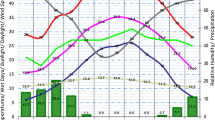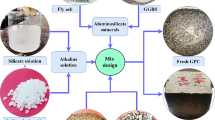Abstract
Concreting and curing under hot climatic conditions pose adverse effects on the characteristics of concrete. These challenges have prompted cement and concrete technologists to incorporate pozzolanic materials for the dual advantages from technical and sustainable perspectives. In this research, the impact of: (1) casting temperature between the range of 25–45 °C, (2) curing regimes, namely water ponding, burlap covering or curing compound, and (3) pozzolanic materials, namely fly ash, very fine fly ash, silica fume, natural pozzolan and ground granulated blast furnace slag on the long-term strength development of concrete have been investigated. Prediction models correlating the investigated variables and concrete strength were developed utilizing quadratic regression models and artificial neural networks (ANNs). ANN models were able to predict the compressive strength of concrete with higher accuracy than that of regression model. This model is expected to be applied for designing concrete of higher strengths under hot weather conditions.

Source: climatemps.com]









Similar content being viewed by others
Abbreviations
- °C:
-
Unit for temperature, degree Celsius
- Y :
-
Output of prediction models (compressive strength of concrete) (MPa)
- X :
-
Vector of input variables
- a, b, c :
-
Coefficients for regression model
- W :
-
Vector of weight values for nodes in artificial neural network
- Yi:
-
Actual value of compressive strength of concrete (MPa) for each sample
- Y’i:
-
Predicted value of compressive strength of concrete (MPa) for each sample
- fc’:
-
Compressive strength of concrete (MPa)
- n :
-
Number of samples
References
ACI Committee 305.: ACI 305R-10 Guide to hot weather concreting
Mehta, P.K.; Monteiro, P.J.M.: Concrete Microstructure, Properties, and Materials. McGraw-Hill, New York (2017)
Al Martini, S.; Al Khatib, M.: An experimental study on the self-consolidating concrete (SCC) under hot weather and hauling time. Key Eng. Mater. 677, 3–7 (2016)
Ortiz, J.; Aguado, A.; Agulló, L.; García, T.: Influence of environmental temperatures on the concrete compressive strength: simulation of hot and cold weather conditions. Cem. Concr. Res. 35(10), 1970–1979 (2005)
Al-Martini, S.; Al-Khatib, M.I.: Rheology of self-consolidating concrete in hot weather conditions. Proc. Inst. Civ. Eng. Constr. Mater. 173(5), 215–226 (2020)
Sawan, J.S.; Qasrawi, H.Y.: Early age properties of Pozzolanic mortars under hot weather. J. Mater. Civ. Eng. 3(3), 165–178 (1991)
Abbasi, A.F.; Al-Tayyib, A.J.; Al-Ali, M.B.: Effect of hot weather on strength of reinforced concrete beams. Cem. Concr. Compos. 14(3), 209–221 (1992)
da Nóbrega, A.C.V.; Mouret, M.; Cassagnabere, F.; Le, V.-A.: Improved 28-day compressive strength of SCC mixed and cured in hot weather: non-conventional behavior. Constr. Build. Mater. 173, 650–661 (2018)
Sawan, J.S.: Strength and shrinkage of natural pozzolanic mortar in hot weather. J. Mater. Civ. Eng. 4(2), 153–165 (1992)
Al-Ani, S.H.; Al-Zaiwary, M.A.K.: The effect of curing period and curing delay on concrete in hot weather. Mater. Struct. 21(3), 205–212 (1988)
Rahal, K.N.: Effects of improper moist curing on flexural strength of slabs cast under hot weather conditions. Constr. Build. Mater. 110, 337–345 (2016)
Ibrahim, M.; Shameem, M.; Al-Mehthel, M.; Maslehuddin, M.: Effect of curing methods on strength and durability of concrete under hot weather conditions. Cem. Concr. Compos. 41, 60–69 (2013)
Nasir, M.; Al-Amoudi, O.S.B.; Al-Gahtani, H.J.; Maslehuddin, M.: Effect of casting temperature on strength and density of plain and blended cement concretes prepared and cured under hot weather conditions. Constr. Build. Mater. 112, 529–537 (2016)
Nasir, M.; Baghabra Al-Amoudi, O.S.; Maslehuddin, M.: Effect of placement temperature and curing method on plastic shrinkage of plain and pozzolanic cement concretes under hot weather. Constr. Build. Mater. 152, 943–953 (2017)
Ahmadi, B.H.: Initial and final setting time of concrete in hot weather. Mater. Struct. 33(8), 511–514 (2000)
Al-Fadhala, M.; Hover, K.C.: Rapid evaporation from freshly cast concrete and the Gulf environment. Constr. Build. Mater. 15(1), 1–7 (2001)
Jain, A.K.; Mao, J.; Mohiuddin, K.M.: Artificial neural networks: a tutorial. Computer (Long. Beach. Calif.) 29(3), 31–44 (1996)
Adeli, H.: Neural networks in civil engineering: 1989–2000. Comput. Civ. Infrastruct. Eng. 16(2), 126–142 (2001)
Amezquita-Sanchez, J.P.; Valtierra-Rodriguez, M.; Aldwaik, M.; Adeli, H.: Neurocomputing in civil infrastructure. Sci. Iran. 23(6), 2417–2428 (2016)
Mauludin, L.M.; Oucif, C.: Computational modeling of fracture in concrete: a review. Front. Struct. Civ. Eng. 14, 586–598 (2020)
Ding, Z.; An, X.: Deep learning approach for estimating workability of self-compacting concrete from mixing image sequences. Adv. Mater. Sci. Eng. 2018 (2018)
Ghafari, E.; Bandarabadi, M.; Costa, H.; Júlio, E.: Prediction of fresh and hardened state properties of UHPC: comparative study of statistical mixture design and an artificial neural network model. J. Mater. Civ. Eng. 27(11), 04015017 (2015)
Erdal, H.; Erdal, M.; Şimşek, O.; Erdal, H.İ: Prediction of concrete compressive strength using non-destructive test results. Comput. Concr. 21(4), 407–417 (2018)
Altinkok, N.; Koker, R.: Modelling of the prediction of tensile and density properties in particle reinforced metal matrix composites by using neural networks. Mater. Des. 27(8), 625–631 (2006)
Jiang, G.; Keller, J.; Bond, P.L.; Yuan, Z.: Predicting concrete corrosion of sewers using artificial neural network. Water Res. 92, 52–60 (2016)
Rasul, M.; Hosoda, A.; Maekawa, K.: Prediction of maximum thermal crack width of RC abutments utilizing actual construction data and study on influential parameters using neural networks. Constr. Build. Mater. 260, 120477 (2020)
Rasul, M.; Hosoda, A.: Prediction of occurrence of thermal cracking of RC abutments using artificial neural networks. J. Struct. Eng. 65, 560–568 (2019)
Nasir, M.; Gazder, U.; Maslehuddin, M.; Baghabra Al-Amoudi, O.S.; Syed, I.A.: Prediction of properties of concrete cured under hot weather using multivariate regression and ANN models. Arab. J. Sci. Eng. 45(5), 4111–4123 (2020)
ASTM C150-19: Standard Specification for Portland Cement. ASTM International, West Conshohocken, PA (2019)
Hossain, M.M.; Karim, M.R.; Hasan, M.; Hossain, M.K.; Zain, M.F.M.: Durability of mortar and concrete made up of pozzolans as a partial replacement of cement: a review. Constr. Build. Mater. 116, 128–140 (2016)
Khan, M.I.; Siddique, R.: Utilization of silica fume in concrete: review of durability properties. Resour. Conserv. Recycl. 57, 30–35 (2011)
Özbay, E.; Erdemir, M.; Durmuş, H.I.: Utilization and efficiency of ground granulated blast furnace slag on concrete properties - a review. Constr. Build. Mater. 105, 423–434 (2016)
Akkaya, Y.; Ouyang, C.; Shah, S.P.: Effect of supplementary cementitious materials on shrinkage and crack development in concrete. Cem. Concr. Compos. 29(2), 117–123 (2007)
Filazi, A.; Demir, İ; Sevim, O.: Enhancement on mechanical and durability performances of binary cementitious systems by optimizing particle size distribution of fly ash. Arch. Civ. Mech. Eng. 20(2), 1–13 (2020)
ASTM C33-18: Standard Specifications for Coarse Aggregates. ASTM International, West Conshohocken, PA (2019)
ASTM C494-19: Standard Specification for Chemical Admixtures for Concrete. ASTM International, West Conshohocken, PA (2019)
ASTM C192-14: Standard Practice for Making and Curing Concrete Test Specimens in the Laboratory. ASTM International, West Conshohocken, PA (2014)
BS 1881–116.: Method for Determination of Compressive Strength of Concrete Cubes (1991)
Binder, J.J.: On the use of the multivariate regression model in event studies. J. Account. Res. 23(1), 370–383 (1985)
Craven, B.D.; Islam, S.M.: Ordinary Least-Squares Regression. Sage Publication, California (2011)
Ives, A.R.: For testing the significance of regression coefficients, go ahead and log transform count data. Methods Ecol. Evol. 6(7), 828–835 (2015)
Yegnanarayana, B.: Artificial Neural Network. PHI Learning Pvt. Ltd., Delhi (2011)
Xu, S.; He, X.: Process Neural Networks: Theory and Applications. Springer Science & Business Media, New York (2010)
Huang, G.B.; Zhu, Q.Y.; Siew, C.K.: Extreme learning machine: a new learning scheme of feedforward neural networks. In: Proceedings. 2004 IEEE International Joint Conference on Neural Networks, pp. 985–90 (2004)
Dawson, C.W.; Wilby, R.: An artificial neural network approach to rainfall-runoff modelling. Hydrol. Sci. J. 43(1), 47–66 (1998)
Wang, L.; Zeng, Y.; Chen, T.: Back propagation neural network with adaptive differential evolution algorithm for time series forecasting. Expert Syst. Appl. 42(2), 855–863 (2015)
Gazder, U.; Al-Amoudi, O.S.B.; Khan, S.M.S.; Maslehuddin, M.: Predicting compressive strength of blended cement concrete with ANNs. Comput. Concr. 20(6), 627–634 (2018)
Ebrahimzadeh, A.; Ahmadi, M.; Safarnejad, M.: Classification of ECG signals using Hermite functions and MLP neural networks. J. Artif. Data Min. 4(1), 55–65 (2016)
Alwakeel, M.; Shaaban, M.: Face recognition based on Haar wavelet transform and principal component analysis via Levenberg-Marquardt backpropagation neural network. Eur. J. Sci. Res. 42(1), 25–31 (2010)
Sapna, S.; Tamilarasi, A.; Kumar, M.P.: Backpropagation learning algorithm based on Levenberg Marquardt Algorithm. Comp Sci. Inf. Technol. (CS IT) 2, 393–398 (2012)
Jin, R.; Chen, W.; Simpson, T.W.: Comparative studies of meta-modelling techniques under multiple modelling criteria. Struct. Multidiscip. Optim. 23(1), 1–13 (2001)
Willmott, C.J.; Matsuura, K.: Advantages of the mean absolute error (MAE) over the root mean square error (RMSE) in assessing average model performance. Clim. Res. 30(1), 79–82 (2005)
Shariq, M.; Prasad, J.; Masood, A.: Studies in ultrasonic pulse velocity of concrete containing GGBFS. Constr. Build. Mater. 40, 944–950 (2013)
Gevrey, M.; Dimopoulos, I.; Lek, S.: Review and comparison of methods to study the contribution of variables in artificial neural network models. Ecol. Modell. 160(3), 249–264 (2003)
Kim, J.K.; Moon, Y.H.; Eo, S.H.: Compressive strength development of concrete with different curing time and temperature. Cem. Concr. Res. 28(12), 1761–1773 (1998)
Yazıcı, H.: The effect of curing conditions on compressive strength of ultra high strength concrete with high volume mineral admixtures. Build. Environ. 42(5), 2083–2089 (2007)
Al-Gahtani, A.S.: Effect of Curing Methods on the Properties of Plain and Blended Cement Concretes. Constr. Build. Mater. 24, 308–314 (2010)
Akbari, M.; Jafari, V.: Data driven models for compressive strength prediction of concrete at high temperatures. Front. Struct. Civ. Eng. 14, 311–321 (2020)
Acknowledgements
The authors acknowledge the financial support provided by King Fahd University of Petroleum and Minerals (KFUPM) under KFUPM research Grant # RG1101.
Author information
Authors and Affiliations
Corresponding author
Ethics declarations
Conflict of interest
The authors declare that they have no conflict of interest.
Rights and permissions
About this article
Cite this article
Nasir, M., Gazder, U., Khan, M.U. et al. Prediction of Strength of Plain and Blended Cement Concretes Cured Under Hot Weather Using Quadratic Regression and ANN Tools. Arab J Sci Eng 47, 12697–12709 (2022). https://doi.org/10.1007/s13369-022-06586-y
Received:
Accepted:
Published:
Issue Date:
DOI: https://doi.org/10.1007/s13369-022-06586-y




